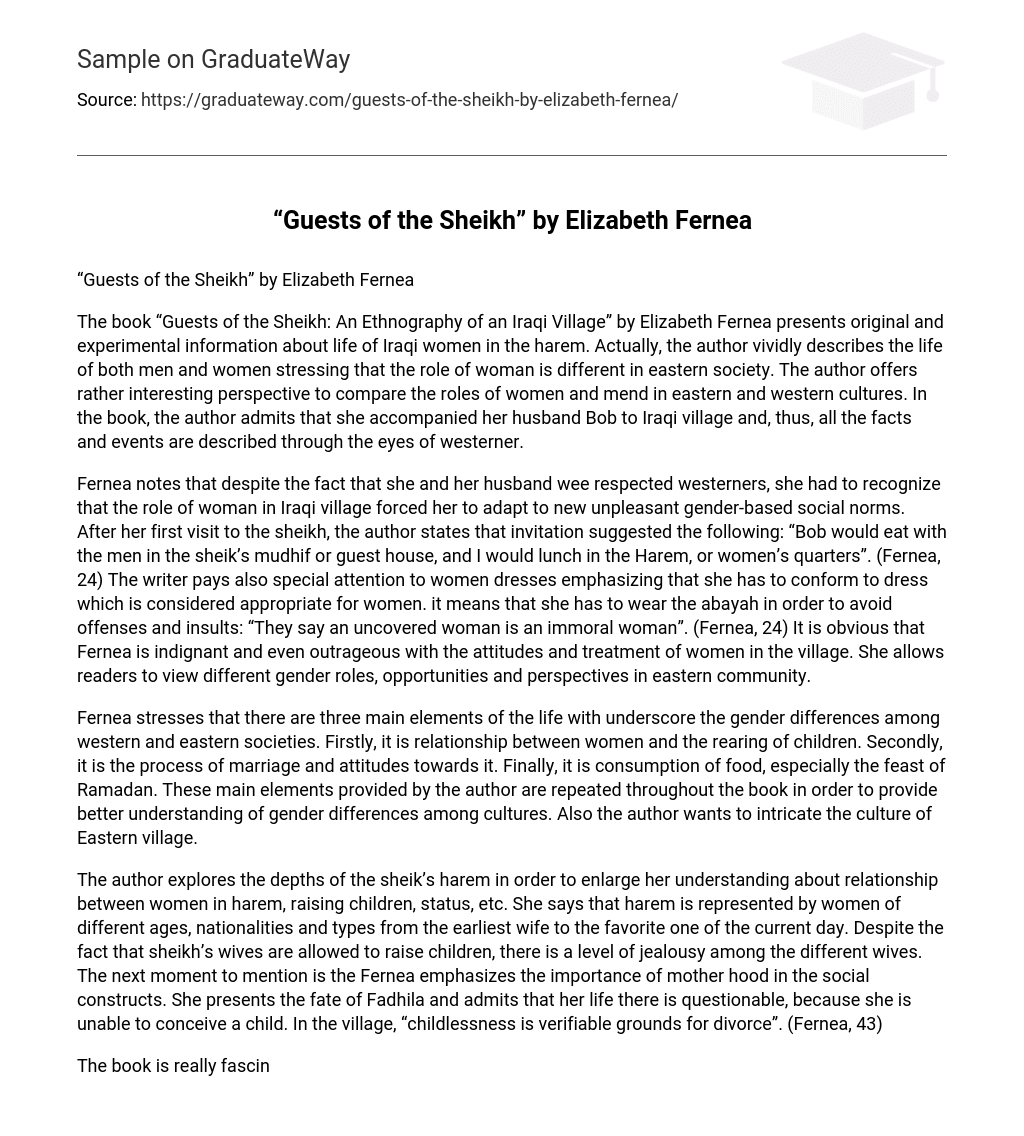The book “Guests of the Sheikh: An Ethnography of an Iraqi Village” by Elizabeth Fernea presents original and experimental information about life of Iraqi women in the harem. Actually, the author vividly describes the life of both men and women stressing that the role of woman is different in eastern society. The author offers rather interesting perspective to compare the roles of women and mend in eastern and western cultures. In the book, the author admits that she accompanied her husband Bob to Iraqi village and, thus, all the facts and events are described through the eyes of westerner.
Fernea notes that despite the fact that she and her husband wee respected westerners, she had to recognize that the role of woman in Iraqi village forced her to adapt to new unpleasant gender-based social norms. After her first visit to the sheikh, the author states that invitation suggested the following: “Bob would eat with the men in the sheik’s mudhif or guest house, and I would lunch in the Harem, or women’s quarters”. (Fernea, 24) The writer pays also special attention to women dresses emphasizing that she has to conform to dress which is considered appropriate for women. it means that she has to wear the abayah in order to avoid offenses and insults: “They say an uncovered woman is an immoral woman”. (Fernea, 24) It is obvious that Fernea is indignant and even outrageous with the attitudes and treatment of women in the village. She allows readers to view different gender roles, opportunities and perspectives in eastern community.
Fernea stresses that there are three main elements of the life with underscore the gender differences among western and eastern societies. Firstly, it is relationship between women and the rearing of children. Secondly, it is the process of marriage and attitudes towards it. Finally, it is consumption of food, especially the feast of Ramadan. These main elements provided by the author are repeated throughout the book in order to provide better understanding of gender differences among cultures. Also the author wants to intricate the culture of Eastern village.
The author explores the depths of the sheik’s harem in order to enlarge her understanding about relationship between women in harem, raising children, status, etc. She says that harem is represented by women of different ages, nationalities and types from the earliest wife to the favorite one of the current day. Despite the fact that sheikh’s wives are allowed to raise children, there is a level of jealousy among the different wives. The next moment to mention is the Fernea emphasizes the importance of mother hood in the social constructs. She presents the fate of Fadhila and admits that her life there is questionable, because she is unable to conceive a child. In the village, “childlessness is verifiable grounds for divorce”. (Fernea, 43)
The book is really fascinating accounting of the day-to-day life of women in one part of the Middle East. The positive point is the information in the book is very detailed meaning that the author talks not only about local customs, but also provides motivations, beliefs why they behave so. Also Fernea describes historical events of the festivals. The style of friend writing is a pleasant discover as well. Furthermore, the author provides her own reflects and reactions to gender differences in eastern village. Fernea described mistakes which she made while living in the village and her willingness to expose her own fallibility is a strong point of the book. In the beginning the author provides detailed lists of people living in the village and their relationships with each other. In such a way she helps readers to keep track of everyone. The end of the book is provided with glossary of Arabic terms. The final chapter talks about what happened to many of villagers after the author returned home. Nevertheless, the book lacks photographs and illustrations to make the narration more true to life. It would be better to she pictures of village, huts where people live, especially the pictures of women in their abayas and men in their dishdashas.
References
Fernea, Elizabeth. (1995).Guests of the Sheikh: An Ethnography of an Iraqi Village. USA, NY: Anchor Books.





